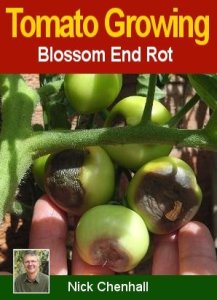Tomato Blossom End Rot (BER) is a problem that is common in medium and large tomato varieties. Dark patches appear at the bottom of the fruit as in the pic below.
The reason for this is that the cell walls of the fruit have been unable to develop properly because of calcium deficiency. This occurs mainly because the compost has been dry when the fruit have been swelling and the plant has been unable to absorb the calcium (through its roots) needed at this crucial stage.
It also occurs if the temperature of the roots is too low which also prevents nutrient absorption (one reason not to sow too early when temperatures are low).

This pic shows just how badly tomatoes are affected by BER. These are yellow plum and you can see how BER has stopped the growth of the underside of these plum tomatoes.
- Dry soil = Roots unable to absorb calcium.
- Soil too cold = Roots unable to absorb calcium.
To help prevent this problem, keep the soil moist, especially if growing in grow bags and containers. The tomatoes already effected are beyond treatment, but thorough and regular watering should ensure that not all tomatoes on the same plant will be affected by blossom end rot.
Foliar feeding is an option and the quickest way to get nutrients into a plant. Check the instructions on the box to make sure that foliar feeding is ok with the plant food you are using.
Chempak Calcium is very good at preventing BER and spraying plants and fruit weekly with milk/water at a 50/50 ratio also works.
Tomatoes grown when the temperature is warmer have access to more of the nutrients in the soil and will be generally healthier.
Cherry varieties aren’t usually effected by blossom end rot because they need less calcium.
Click Here for more!


